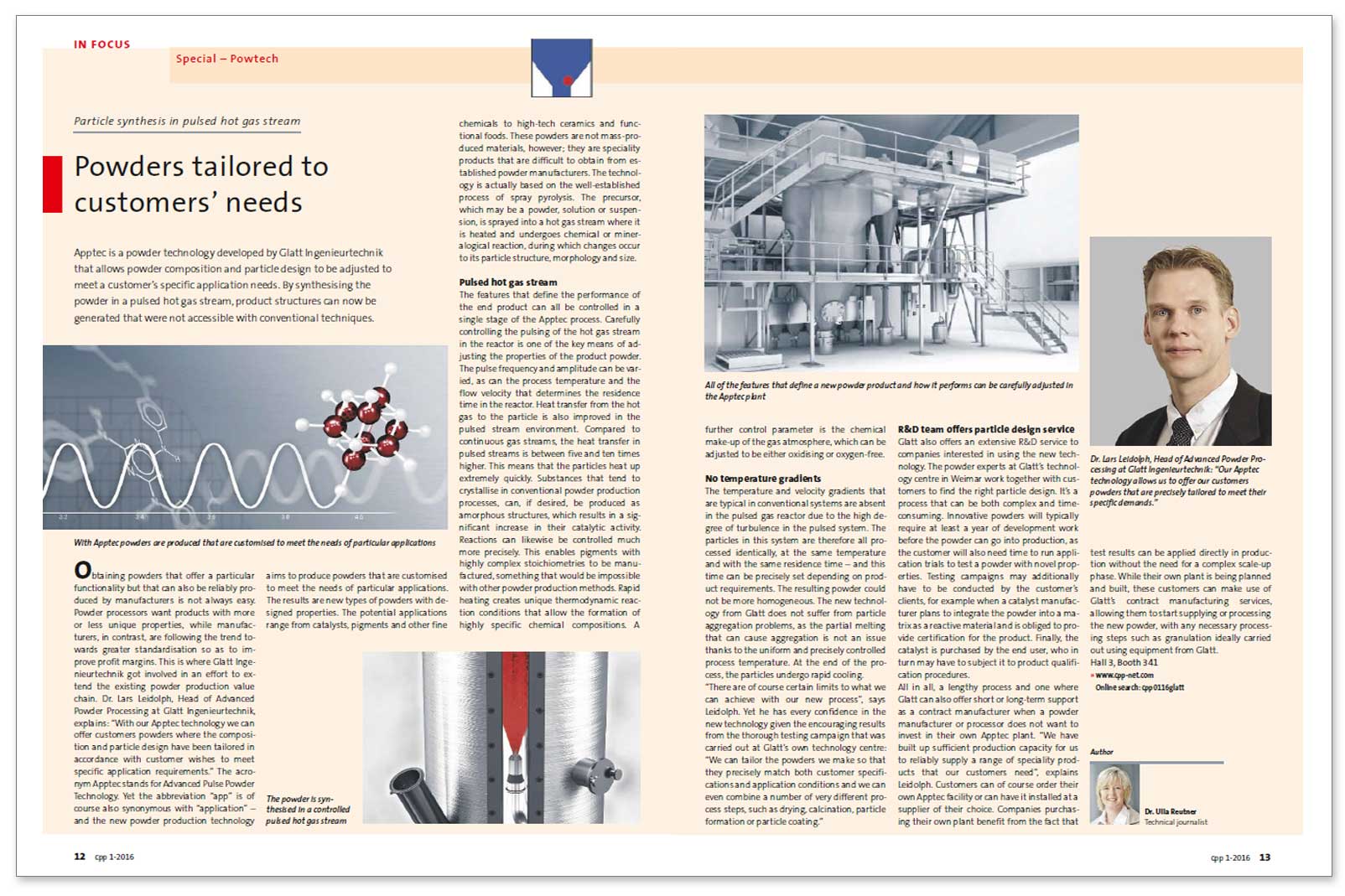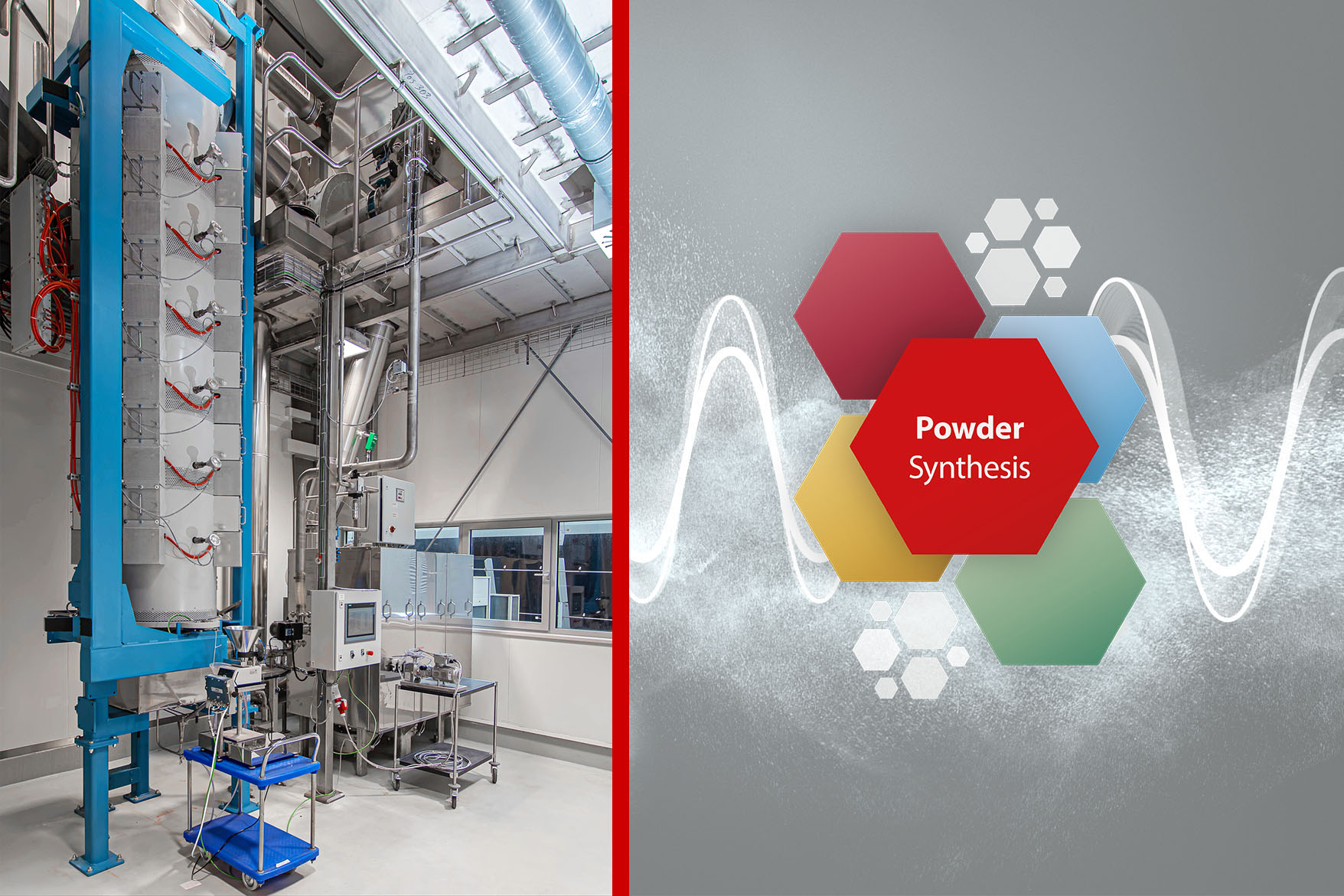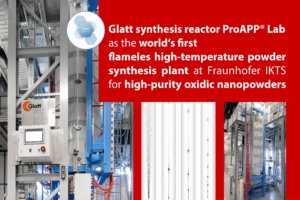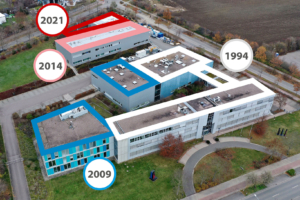Particle synthesis in pulsed hot gas stream: Powders tailored to customers’ needs
Glatt Ingenieurtechnik developed a new powder technology that allows powder composition and particle design to be adjusted to meet a customer’s specific application needs. By synthesising the powder in a pulsed hot gas stream, product structures can now be generated that were not accessible with conventional techniques.
- author: Dr. Ulla Reutner, independent editor
- originally published in the magazing ‘cpp – chemical plants processing’, issue 01/2016 pages 12–13 (Konradin Verlag Robert Kohlhammer GmbH)
- Powders tailored to customers’ needs (process-technology-online.com)
- keywords: particle synthesis, particle design, powder generation, powder synthesis
Obtaining powders that offer a particular functionality but that can also be reliably produced by manufacturers is not always easy. Powder processors want products with more or less unique properties, while manufacturers, in contrast, are following the trend towards greater standardization so as to improve profit margins. This is where Glatt Ingenieurtechnik got involved in an effort to extend the existing powder production value chain. Dr. Lars Leidolph, Head of Advanced Powder Processing at Glatt Ingenieurtechnik, explains: “With our APPtec® technology we can offer customers powders whose composition and particle design have been tailored in accordance with customer wishes to meet specific application requirements.” The acronym APPtec® stands for Advanced Pulse Powder Technology. But the abbreviation “app” is of course also synonymous with “application” – and the new powder production technology from Glatt aims to produce powders that are customized to meet the needs of particular applications. The result is new types of powders with designed properties. Applications range from catalysts, pigments and other fine chemicals to high-tech ceramics and functional foods. But these powders are not mass-produced materials, they are speciality products that are difficult to obtain from established powder manufacturers. The technology is actually based on the well-established process of spray pyrolysis. The precursor, which may be a powder, solution or suspension, is sprayed into a hot gas stream where it is heated and undergoes chemical or mineralogical reaction, during which changes to particle structure, morphology and size occur.
Pulsed hot gas stream
The features that define the performance of the end product can all be controlled in a single stage of the APPtec® process. Carefully controlling the pulsing of the hot gas stream in the reactor is one of the key means of adjusting the properties of the product powder. Pulse frequency and amplitude can be adjusted, as can process temperature and the flow speed that determines residence time in the reactor. Heat transfer from the hot gas to the particle is also improved in the pulsed stream environment. Compared to continuous gas streams, the heat transfer in pulsed streams is between five to ten times higher. This means that the particles heat up extremely quickly. Substances that tend to crystallize in conventional powder production processes, can, if desired, be produced as amorphous structures, which results in a significant increase in their catalytic activity. Reactions can also be controlled much more precisely. This enables pigments with highly complex stoichiometries to be manufactured, something that would be impossible with other powder production methods. Rapid heating creates unique thermodynamic reaction conditions that allow the formation of highly specific chemical compositions. A further control parameter is the chemical make-up of the gas atmosphere, which can be adjusted to be either oxidizing or oxygen-free.
No temperature gradients
The temperature and velocity gradients that are typical in conventional systems are absent in the pulsed gas reactor due to the high degree of turbulence in the pulsed system. The particles in the system are therefore all processed identically, at the same temperature and with the same residence time. And the residence time can be precisely set depending on product requirements. The resulting powder could not be more homogeneous. The new technology from Glatt does not suffer from particle aggregation problems, as the partial melting that can cause aggregation is not an issue thanks to the precisely controlled and uniform process temperature. At the end of the process, the particles undergo rapid cooling.
“There are of course certain limits to what we can achieve with our new process,” says Leidolph. But he has every confidence in the new technology given the encouraging results from the thorough testing campaign that was carried out at Glatt’s own technology center: “We can tailor the powders we make so that they precisely match both customer specifications and application conditions and we can even combine a number of very different process steps, such as drying, calcination, particle formation or particle coating.”
R&D team offers particle design service
Glatt also offers an extensive R&D service to companies interested in using the new technology. The powder experts at Glatt’s technology center in Weimar work together with customers to find the right particle design. It’s a process that can be both complex and time-consuming. Innovative powders will typically require at least a year of development work before the powder can go into production, as the customer will also need time to run application trials to test a powder with novel properties. Testing campaigns may also have to be conducted by the customer’s clients, for example when a catalyst manufacturer plans to integrate the powder as a reactive material into a matrix and needs to provide certification for its product. And finally, the catalyst gets purchased by the end user who in turn may need to subject it to product qualification procedures.
All in all, a lengthy process and one where Glatt can also offer short or long-term support as a contract manufacturer when a powder manufacturer or processor does not want to invest in its own APPtec® plant. “We have built up sufficient production capacity for us to reliably supply a range of speciality products that our customers need,” explains Leidolph. Customers can of course order their own APPtec® facility or can have it installed at a supplier of their choice. Companies purchasing their own plant benefit from the fact that test results can be used directly for production without the need for a complex scale-up phase. While their own plant is being planned and built, customers can make use of Glatt’s contract manufacturing services, which allows them to start supplying or processing the new powder, with any necessary processing steps, such as granulation, ideally carried out using equipment from Glatt.
Further information on this topic and related topics can also be found in the following publications:
June 2021: ‘Fraunhofer IKTS operates world’s first flameless high-temperature powder synthesis plant’
Published article: ‘Ceramic Raw Materials from the Pulsating Hot Gas Stream’ PDF, English
Published article: ‘New Battery Material by Powder Synthesis’ PDF, English







 Copyright: Hüthig GmbH
Copyright: Hüthig GmbH Vereinigte Fachverlage GmbH
Vereinigte Fachverlage GmbH